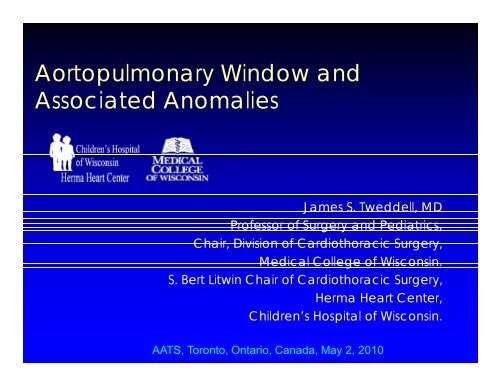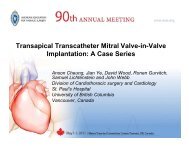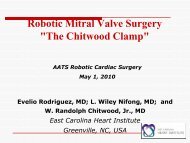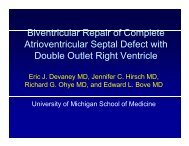Aortopulmonary Window and Associated Anomalies
Aortopulmonary Window and Associated Anomalies
Aortopulmonary Window and Associated Anomalies
You also want an ePaper? Increase the reach of your titles
YUMPU automatically turns print PDFs into web optimized ePapers that Google loves.
<strong>Aortopulmonary</strong> <strong>Window</strong> <strong>and</strong><strong>Associated</strong> <strong>Anomalies</strong>James S. Tweddell, MDProfessor of Surgery <strong>and</strong> Pediatrics,Chair, Division of Cardiothoracic Surgery,Medical College of Wisconsin.S. Bert Litwin Chair of Cardiothoracic Surgery,Herma Heart Center,Children’s Hospital of Wisconsin.AATS, Toronto, Ontario, Canada, May 2, 2010
Disclosures•Financial disclosures–Consultant for Cubist Pharmaceuticals–Consultant for SheringPlough Corporation
<strong>Aortopulmonary</strong> <strong>Window</strong>• The result of failure of fusion ofthe two opposing conotruncalridges that are responsible forseparating the truncus arteriosusinto the aorta <strong>and</strong> pulmonaryartery.• APW occurs between theascending aorta <strong>and</strong> the mainpulmonary artery <strong>and</strong> may befound just above the semilunarvalves or between the moredistal ascending aorta <strong>and</strong>main pulmonary artery.
ClassificationMori, K et al British Heart Journal 1978
Classification•Perhaps more a continuum?Backer <strong>and</strong> Mavroudis EJCTS 2002
Classification –APW with IAA• Embryology of aortopulmonary windowincluding interrupted aortic archBerry, T et al American Journal Cardiology 1982
Classification –APW with IAAKonstantinov et al JTCVS 2006
Antenatal Diagnosis•First reported by Collinet et al 2002.–Simple aortopulmonary window may notbe identified by fetal echocardiographybecause equal pressure in the ascendingaorta <strong>and</strong> pulmonary root.•Antenatal diagnosis ofaortopulmonary window withinterrupted aortic arch first reported in2009 by Hayashi et al–Posterior deviation of the outlet septum isabsent.
Presentation•Similar to that of other patients withlefttoright shunts, such as PDA or VSD<strong>and</strong> depends on the size of the defect.•congestive heart failure–tachypnea–diaphoresis–poor feeding–inadequate weight gain are common.with large defects, bidirectional shuntingcan produce systemic desaturation.
Presentation• Physical exam– tachypneic infant with accessory respiratorymuscle use.– Cardiac examination reveals an enlarged heart,<strong>and</strong> like patients with patent ductus arteriosus,the pulses are bounding.– A systolic murmur can be heard along the leftsternal border; however, unlike patients with apatent ductus arteriosus, a diastolic componentto the murmur is rare.– Patients with associated arch abnormalitiesfrequently present with shock coinciding withclosing of the ductus arteriosus.
Presentation• The diagnosis is routinelymade withechocardiography.• The location <strong>and</strong> size of thecommunication as well asassociated anomalies arecarefully identified.• Cardiac catheterization isoccasionally indicated for thepatient who presents afterearly infancy to assesspulmonary vascular resistanceGangana et al Arq Bras Cardiol 2007
Presentation•MRIGarver, K. A. et al. Circulation 1997
Presentation•<strong>Associated</strong> cardiac lesions >50% (otherthan ASD <strong>and</strong> PDA)–Arch anomalies; arch hypoplasia/coarct arch interruption onethird–VSD–RVOT anomalies; TOF, PS, PA/IVS, aorticorigin of RPA–LVOTO–Transposition–Coronary anomalies
Indications for intervention•Presence of an aortopulmonarywindow is an indication for treatment–Very small window could be followed <strong>and</strong>ultimately closed using catheter basedtechniques•Small to moderate intermediate APWmay be suitable for device closure–Access in a small infant may be difficult•Repair is best accomplished using CPB
Preoperative management•Resuscitation limiting excessive pulmonaryblood flow– requires intubation <strong>and</strong> mechanical– sedation ± neuromuscular blockade– hypercapnea <strong>and</strong> minimizing FIO 2 will increasethe pulmonary vascular resistance, decrease lefttorightshunting, <strong>and</strong> improve systemic oxygendelivery.– Inotropic support may be required.• Prostagl<strong>and</strong>in infusion is necessary inpatients with Interrupted aortic arch
Su rg ic a l R e p a ir o f A P WYear Surgeon Method1948 Gross Ligation1953 Scott <strong>and</strong> Sabiston Division without cardiopulmonary bypass1957 Cooley et al Division with cardiopulmonary bypass1966 Putnam <strong>and</strong> Gross Transpulmonary patch closure19671968 Negre et alBircksJohansson et alAnterior s<strong>and</strong>wich patch closure1968 Wright et al Transaortic suture closure1969 Deverall et al Transaortic patch closure1987 Shatapathy et al Pulmonary artery flap closure1992 Matsuki et al Anterior pulmonary artery flap closureFrom Gaynor in Pediatric Cardiac Surgery
Operative technique – APW• Median sternotomy• Inspection– Extent of APW– Evidence ofanomalous coronaryarteries
Operative technique – APW• Preparation for CPB– Encircle branchpulmonary arteries– Arterial cannulation– Single venouscannulation unlessassociated intracardiacrepair is necessary• Once CPB initiatedbranch PAs are snared– Mild hypothermia– Antegrade cardioplegia
Operative technique – APW• Repair of APW canbe accomplishedusing an incisionthrough the aorta,pulmonary artery orthe aortopulmonarywindow
Operative technique – APW• Repair of APW bestaccomplishedthrough an incisionin the window itself– Incision initiated inthe superior aspect– Identify the positionof coronary originsbefore continuing– Single patch ofGoreTex
Operative technique – APW• Single suture line• Anteriorly suture lineis used to completeclosure of aorta <strong>and</strong>pulmonary artery
Operative technique –APW with IAA• <strong>Aortopulmonary</strong> window with interrupted aortic archPDAType A IAAMPARPA origin from ascending aorta
Operative technique –APW with IAA
Operative technique –APW with IAA
Operative technique –APW with IAA
Results of repair• Outcome dependent on era of surgery <strong>and</strong>presence of additional anomalies– APW with IAA associated with increased time relatedmortality, hazard ratio = 5.87, p = 0.009Bagtharia et al Cardiol Young 2004
Children’s Hospital of Wisconsin experience• Between 1983 <strong>and</strong> 2009 n = 24• Simple APW (n = 11)• Complex APW (n = 13)– IAA or coarctation of the aorta (n = 8),– VSD (n = 1),– PA/VSD <strong>and</strong> anomalous origin of the rightcoronary artery (n = 1),– PA/IVS <strong>and</strong> PAPVR (n = 1),– dtransposition of the great vessels (n = 1)– congenital absence of the left pulmonary arterywith pulmonary artery hypertension (n = 1).
Children’s Hospital of Wisconsin experience• Simple APW– No early or late mortality• Complex APW– Early mortality = 1 APW, pulmonary atresia <strong>and</strong>intact ventricular septum <strong>and</strong> PAPVR.– Late mortality = 1 Following lung transplantationin the patient with APW, absent left pulmonaryartery <strong>and</strong> pulmonary hypertension.– Morbidity –one patient underwent surgical repairof residual arch obstruction
Conclusion•In the current era results with APW areexcellent, mortality is rare <strong>and</strong> isassociated with concomitantanomalies•Longterm followup is indicated–Branch pulmonary artery stenosis–Recurrent arch obstruction
Thank you
















